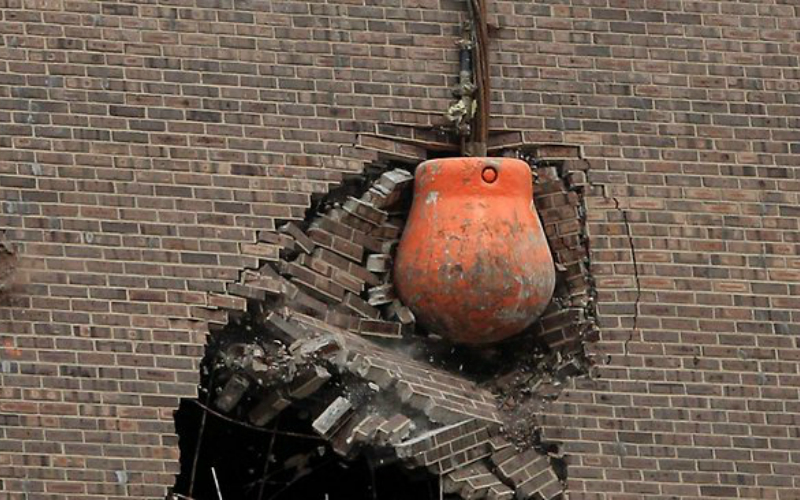The Biden administration must spend funds allocated by Congress to build a wall on the southern border, a federal judge ruled Friday. Southern District of Texas Judge Drew Tipton sharply rebuked the Department of Homeland Security for contending that, “notwithstanding the language in the statute,” it had discretion to spend the money however it pleased.
“Whether the Executive Branch must adhere to federal laws is not, as a general matter, an area traditionally left to its discretion,” Tipton, a Trump appointee, remarked dryly.
As usual, this lawbreaking by the Executive Branch is traceable back to the nation’s chief executive. On his first day in office, President Joe Biden issued a proclamation declaring that “it shall be the policy of my Administration that no more American taxpayer dollars be diverted to construct a border wall.”
The proclamation, as Tipton noted, paused all spending on a border wall and directed DHS to devise other ways to spend the allocated funds.
This language was already misleading because the word “divert” means “to turn from one course or use to another.” To quote from the ruling, “In 2020 and 2021, Congress funded roughly $1.4 billion ‘for the construction of [a] barrier system along the southwest border.’” Thus, by halting construction, President Biden was responsible for diverting funds from one purpose to another. The issue was funds being diverted from, not to, border wall construction.
In compliance with Biden’s proclamation, but in defiance of Congress’s allocation restrictions, DHS dreamed up plans to spend most of the money on “smarter border security measures” (a.k.a. technology systems, not a wall), “environmental remediation, flood-control, and cleanup projects.” Under these plans, the DHS would only construct new barriers “in two locations where they are filling gaps in existing walls,” according to the testimony of their own expert.
“The Biden Administration has failed to abide by the law to finish the construction of a wall along the southwest border,” said Missouri Attorney General Andrew Bailey (R). “Joe Biden refuses to carry out his constitutionally mandated responsibilities, so we took him to court to force him to do his job.”
In response to the Biden administration’s fantastical interpretation of “construction of [a] barrier system,” the judge threw the dictionary at them.
“The definitions of ‘construction’ and ‘barrier’ connote building a physical structure that would serve as a barricade and a line of demarcation,” he wrote, after quoting from Merriam-Webster. “‘System’ accounts for the large scale of the U.S.-Mexico border requiring different kinds of barriers such as walls, fencing, buoys and the like.” Obviously, “this plain meaning does not include the Government’s definition,” Tipton concluded.
Tipton proceeded to analyze surrounding text in the same appropriations law.
“Congress broke [the relevant section] down into five distinct subsections” and stipulated that “these funds ‘shall be available only as follows,’” he acknowledged. So, funds allocated in one category couldn’t be diverted to a purpose in another category. The following section of the law gave “currently deployed steel bollard designs” as an example of one type of barrier DHS was authorized to construct with the funds, demonstrating that Congress clearly intended the funds to cover the construction of the actual barrier.
Tipton further reasoned that DHS’s creative plans to reallocate border barrier funds fell into the other subcategories. Except for a “generalized catch-all,” each section had “clearly separate and distinct purposes,” with one funding a border barrier, another “border security technologies,” another “facility construction and improvements,” and yet another “integrated operations assets and infrastructure.” These distinct categories described all the other projects DHS had in mind.
The agency’s discretion over spending projects did not extend so far, the judge argued. It would be one thing if the states who challenged the administration’s decision (Texas and Missouri) simply objected to DHS’s decision to pursue or not pursue any particular spending project. Instead, a fundamental part of their argument was that “DHS was specifically obligated to spend the CAA funds to construct border walls, and the decision to not do so … was outside DHS’s discretion and violated the law.”
This distinction was important because, instead of turning the argument into a question of federal authority versus state authority, it became an argument over whether Congress or an executive agency had authority over spending.
“The central question in this case, then, is this: Has the Government obligated FY 2020 and FY 2021 funds for the ‘construction of [a] barrier system’?” the judge asked. He answered, “The answer is largely no.”
This is not just the opinion of a single federal judge out in Texas. Tipton quoted from a 1993 Supreme Court opinion, Lincoln v. Vigil, “an agency is not free simply to disregard statutory responsibilities: Congress may always circumscribe agency discretion to allocate resources by putting restrictions in the operative statutes.”
Given this legal slam dunk, the judge issued a preliminary injunction, preventing any parts of the DHS’s plan that did not involve the “construction of physical barriers, such as additional walls, fencing, buoys, etc.” and prohibiting them from obligating the funds in question “toward mitigation and remediation efforts, repair of existing barrier, so-called system attribute installation at existing sites, or other similar purposes.”
During a previous hearing in the Southern District of Texas, a federal judge had dismissed Texas’s border wall lawsuit for a lack of standing, but then the Fifth Circuit reversed that decision and remanded the case in July 2023.
This lawsuit forms part of a legal maelstrom darkening relations between Texas and the Biden administration over its handling of the border. Other lawsuits taking place concurrently involve Texas’s attempt to arrest illegal immigrants, place razor wire along the border, or place buoy barriers in the Rio Grande River.
Given the larger legal context surrounding the southern border, not to mention political controversy making illegal immigration a top issue in the 2024 election, the opinion contained several findings that could be significant beyond the scope of this one ruling. Specifically, the court acknowledged the Biden administration’s border crisis had inflicted real injury on the state of Texas because of the costs the state has incurred in dealing with it.
Beyond that, the court also found “that Texas has demonstrated that its injuries are traceable to DHS’s funding decisions.” Texas submitted the DHS’s own documents to prove to the court that “constructing additional border barriers will reduce illegal entries in areas where those walls are constructed, increase detection rates across the entire border, and generally disincentivize illegal immigration.”
In other words, the Biden administration knew that constructing barriers would at least hinder illegal immigration, yet from January 20, 2021, it has deliberately chosen to pursue a policy of not constructing border barriers. In late January, President Biden told reporters, “I’ve done all I can do” to secure the border. According to this federal court’s findings, DHS’s own documents prove that statement false.
This article appeared originally here.
Notice: This column is printed with permission. Opinion pieces published by AFN.net are the sole responsibility of the article's author(s), or of the person(s) or organization(s) quoted therein, and do not necessarily represent those of the staff or management of, or advertisers who support the American Family News Network, AFN.net, our parent organization or its other affiliates.








